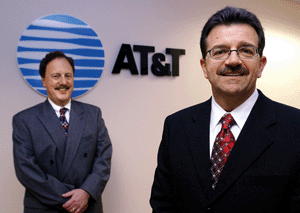On Jan. 17, AT&T Corp. began work on a two-week project to consolidate and upgrade NASA's fragmented Web-hosting infrastructure. The space agency needed greater capability to handle the increasing volume of traffic and data transmissions at its Web sites.AT&T built a hosting facility within its Ashburn, Va., center, first creating a caching service to handle information distribution to various sites, then taking on the hosting itself, and then providing the professional services to keep everything running effectively around the clock. The reconfigured site was up and running by midnight Friday, Jan. 31. Saturday morning, within hours of the job's completion, the Web site was put to an astonishing test when the space shuttle Columbia came apart during re-entry, killing all seven crew members. That day, the NASA Web site had 75 million hits, close to 500 gigabytes of traffic. By the end of that first week, the hits had climbed to 317 million -- two terabytes of data -- approximately the volume NASA had forecast for the next five years.At less than $1 million, this was a relatively small-dollar contract, but it reflects one of the trends in IT infrastructure that AT&T of Bedminster, N.J., and other federal contractors are seeing.The IT infrastructure -- an agency's interrelated connection of networks, servers, processors, communication's links and other hardware -- is more important than ever. Agencies need reliable, redundant, instant and continuous communication of voice, data and video, whether to handle routine business or the demands of a crisis. But federal agencies are unwilling to spend large amounts of money on new equipment or emerging technologies. Gone are the days of investing in technology just because it's new and there's unspent money in the budget, said Mike Chandler, president of General Dynamics Corp.'s network systems business.In fact, the government is doing something unexpected: It's looking to reuse and recycle its own assets."[The customer] is saying, 'As you upgrade this infrastructure, tell me where I can save money by finding dark fiber [and] we'll light it up and lease it,' " Chandler said. "The same is true in the satellite communications arena. ... It's very much a change from the days of technology for its own sake."Agencies are following NASA's path, looking to combine resources, eliminate duplication and stretch budgets while furthering their missions. "There is the relentless drive to use Web services wherever possible," said Bob Collet, chief engineer for AT&T's government services unit. "There's a great deal of legacy out there, so trend No. 1 is the placement of Web services interfaces and building systems around an architecture across an agency, with the Web services making access possible." MAKING THE BUSINESS CASEThe push to consolidate and reuse IT infrastructure is driven in large measure by the Office of Management and Budget's requirement that agencies make a business case for their IT investments.[IMGCAP(2)]"IT infrastructure modifications, changes and improvements will be looked at skeptically unless there's a perceived opportunity to reduce costs. ... There will be budget pressures for the foreseeable future," said Warren Suss, president of Suss Consulting Inc. in Jenkintown, Pa.Michael Beckley, co-founder of Appian Corp., Vienna, Va., said Defense Secretary Donald Rumsfeld is pushing the military services to consolidate IT infrastructure as part of his effort to improve interoperability and create a network-centric military."Take a look at the major drivers behind what Rumsfeld calls transformation," said Beckley, whose company built the Army Knowledge Online portal. "What that translates into at the service level is specific demands by service chiefs to reduce applications and systems by 50 percent."The push for agencies to make smart, collaborative decisions about IT infrastructure has slowed somewhat the adoption of new technologies, according to industry and government officials. Voice over IP, for example, is an important emerging technology, but it might have trouble passing the business-case test, said Chris Fornecker, chief technology officer for the General Services Administration."Voice over IP for long-distance calling is a great question for us to tackle," he said. But because the Federal Technology Service negotiates great long-distance rates for government agencies, "it's not clear that voice over IP buys us much," he said.The agency is looking at pilot programs to evaluate whether switching to the new technology is cost-effective, Fornecker said.Wireless is another technology vulnerable to the business-case gauntlet."There's a lot of interest [in wireless] but not a lot of spending. Yes, it is a trend. Yes, it is coming, but a lot more slowly," Appian's Beckley said. "Strangely enough, while Sept. 11 demonstrated the need for wireless, it also demonstrated its vulnerabilities to being overwhelmed and the need for disaster recovery."[IMGCAP(3)]Mollie Andrews, vice president of Cox Business Services, a division of Cox Communications Inc., an Atlanta-based cable television provider, said the security issues that linger around wireless technologies are the impediment. "All the questions are not yet answered," she said.Cox is exploring how to use wireless to expand its wired networks, particularly on military bases, where the company has developed a business selling dual-entrance, redundant broadband services, she said.Concerns about spectrum availability also are slowing the spread of wireless, particularly for first responders, said Royce Kincaid, program manager for wireless initiatives at Northrop Grumman IT, a unit of Los Angeles-based Northrop Grumman Corp. That's why his company last month sent a petition to the Federal Communications Commission asking that it dedicate a larger portion to those users.Kincaid said Northrop Grumman is focusing on how to incorporate legacy technologies into new wireless solutions. Pointing to Steve Cooper, chief information officer at the Homeland Security Department, Kincaid said Cooper's priorities include establishing a converged, high-speed broadband network, wireless capabilities and geospatial information systems. "What we're proposing is infrastructure that is backward compatible [with the] main radios used by law enforcement and public safety," he said. BUYING TRENDSAgency purchases of IT infrastructure are increasingly buried inside larger contracts, as is the case with the request for proposals for the Army's Information Technology Enterprise Solutions contract, worth up to $800 million and due out in July. Consequently, systems integrators are continuing their push into the IT infrastructure space.Integrators are now winning the infrastructure contracts that years ago were won by telecom and network service providers, said Jim Orefice, vice president, government markets, with Lucent Technologies Inc., Murray Hill, N.J. [IMGCAP(4)]The Federal Aviation Administration Telecommunications Infrastructure contract, awarded last summer to Harris Corp. of Melbourne, Fla., is the paradigm for such program. Harris, as systems integrator, put together a team of regional Bell operating companies and Sprint Corp. as the long-distance carrier."The government appears to be looking to integrators to provide soup-to-nuts solutions, [including] long-term maintenance and installation," Orefice said.For companies such as Lucent, this means they must look for ways to partner with the large primes. "You still have to market to the end user: the government," Orefice said. "But now the emphasis is on teaming with integrators or becoming an integrator. ... If you're viewed as a prime or nothing, then you don't get on the teams."Agencies also are more frequently purchasing IT infrastructure as a fixed-price commodity, whether for products or services. NASA's ODIN contract for outsourcing desktop services is like this, said Rick Johnson, vice president and chief technology officer of Lockheed Martin Corp.'s information technology group. In ODIN, Lockheed Martin established a set price, for example, for upgrading one piece of software to another, combining elements of both product pricing and service delivery into one purchase."The agencies can take what was a variable cost and turn it into a fixed cost," Johnson said. "We deliver a service for a price, they sign up for the service and pay for it like a commodity."Keeping abreast of the changing infrastructure environment is challenging, said Lou Addeo, recently named president of AT&T Government Solutions."These trends will also be a test for skills and competencies in the agencies and the vendors themselves," Addeo said. "It will be a matter of investment on both parties' parts -- not only being ready to incorporate technology, but to discern whether it's valuable" to the customer. *Staff Writer Patience Wait can be reached at pwait@postnewsweektech.com.XXXSPLITXXX-Postal Service Pre-RFP Expected in July $3 billion over 10 yearsProvide telecommunications managed network services, including computer and telecommunications security, cabling, network services and operations and others. Coast Guard and the Homeland Security Department Pre-RFP Expected in June $10 billion over 10 years SPIRIT will provide services in four functional areas: information management analysis and planning, systems engineering and design, operations and management, and security. The contract will be a multiple award vehicle with full and open competition as well as spots reserved for small businesses.General Services Administration Pre-RFP Expected in July $20 billion over five yearsThis contract, known as FAST 2, is a multiple award, indefinite delivery, indefinite quantity contract reserved for 8(a) companies. The contract has eight functional areas for services, such as design, development, programming, data hosting, facilities management and Internet publishing and broadcasting.Treasury Department Pre-RFP Expected in July$1 billion over three years The Treasury Department wants to build a secure wireless network that its various components can use. Services include consulting and design, training, operations and systems integration.National Science Foundation Pre-RFP Expected in June 2004 $1 billion over five yearsNSF wants to upgrade the computer infrastructure supporting its research and engineering efforts. Defense Information Systems AgencyPre-RFP Expected in June 2004 $1 billion over an undetermined length of time. This contract is still being developed, but analysis and concept exploration tasks are in progress under other contracts looking into whether it should become a program. This contract would give users access of information available through defense and intelligence community networks. The information would be made available as fast as possible, regardless of the where the user is.Patent and Trademark Office Pre-RFPExpected in June 2004$350 million over eight years This agency has a continuing requirement for increased use of automation to support communications between applicants and examiners, for management of patent applications and for related requirements. The first contract was awarded to teams led by Lockheed Martin Corp. and Computer Sciences Corp.XXXSPLITXXX-The General Services Administration has been taking steps to centralize much of its IT procurement and administration in order to hold down costs and ease maintenance responsibilities.For instance, GSA awarded a contract to Intelligent Decisions Inc. in October 2001 that centralized purchasing for desktop computers and servers. Everyone in the agency must either buy through the contract or secure a waiver, said Chris Fornecker, GSA's chief technology officer."We limited the configurations to GSA-approved configurations, and we control [them]," he said. While employees have some choices, they're limited to two basic formats, a high-end or a low-end configuration.Besides providing a degree of control in managing applications and networks, the agency was able to lock in a discount on the price of the equipment."The prices are not fixed, since the technology is constantly changing, but the percentage discount is fixed ... in the neighborhood of 10 to 20 percent," Fornecker said.Meanwhile, GSA also has maintained centralized management of its network and has executed enterprisewide software licenses with key providers.These changes provide a variety of benefits. For example, Fornecker cited security policies regarding password use."The policy is to change your password every 90 days [and include] a certain level of complexity in the password, but it hasn't been enforced," he said. "Now that there is a single database of all user accounts, we can start talking about [enforcing it]."
AT&T Government Services, led by Lou Addeo (right), president, and Robert Collet, chief engineer, reconfigured NASA's Web site in just two weeks. A few hours after the site's launch, the space shuttle Columbia broke apart; the site received more than 75 million hits that day.
Olivier Douliery
"Take a look at the major drivers behind what Rumsfeld calls transformation. What that translates into at the service level is specific demands by service chiefs to reduce applications and systems by 50 percent." ? Michael Beckley of Appian Corp.
Olivier Douliery
Royce Kincaid, program manager for wireless initiatives at Northrop Grumman IT, says the spread of wireless, particularly for first responders, has been slower than expected, in part because of concerns over spectrum availability.
Henrik g. de Gyor
"IT infrastructure modifications, changes and improvements will be looked at skeptically unless there's a perceived opportunity to reduce costs. There will be budget pressures for the foreseeable future." ? Warren Suss of Suss Consulting Inc
Olivier Douliery






